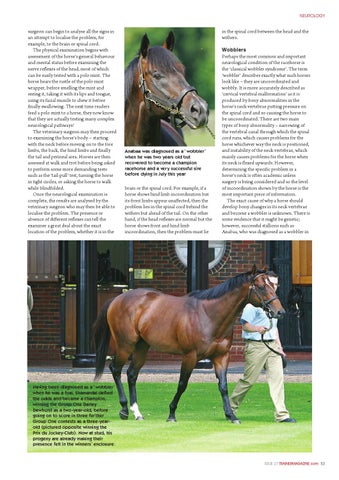NEUROLOGY ISSUE 27.qxd:Jerkins feature.qxd
21/8/09
13:26
Page 2
NEUROLOGY
surgeon can begin to analyse all the signs in an attempt to localise the problem, for example, to the brain or spinal cord. The physical examination begins with assessment of the horse’s general behaviour and mental status before examining the nerve reflexes of the head, most of which can be easily tested with a polo mint. The horse hears the rustle of the polo mint wrapper, before smelling the mint and seeing it, taking it with its lips and tongue, using its facial muscle to chew it before finally swallowing. The next time readers feed a polo mint to a horse, they now know that they are actually testing many complex neurological pathways! The veterinary surgeon may then proceed to examining the horse’s body – starting with the neck before moving on to the fore limbs, the back, the hind limbs and finally the tail and perineal area. Horses are then assessed at walk and trot before being asked to perform some more demanding tests such as the ‘tail-pull’ test, turning the horse in tight circles, or asking the horse to walk while blindfolded. Once the neurological examination is complete, the results are analysed by the veterinary surgeon who may then be able to localise the problem. The presence or absence of different reflexes can tell the examiner a great deal about the exact location of the problem, whether it is in the
in the spinal cord between the head and the withers.
Anabaa was diagnosed as a ‘ wobbler’ when he was two years old but recovered to become a champion racehorse and a very successful sire before dying in July this year
brain or the spinal cord. For example, if a horse shows hind limb incoordination but its front limbs appear unaffected, then the problem lies in the spinal cord behind the withers but ahead of the tail. On the other hand, if the head reflexes are normal but the horse shows front and hind limb incoordination, then the problem must lie
Wobblers Perhaps the most common and important neurological condition of the racehorse is the ‘classical wobbler syndrome’. The term ‘wobbler’ describes exactly what such horses look like – they are uncoordinated and wobbly. It is more accurately described as ‘cervical vertebral malformation’ as it is produced by bony abnormalities in the horse’s neck vertebrae putting pressure on the spinal cord and so causing the horse to be uncoordinated. There are two main types of bony abnormality – narrowing of the vertebral canal through which the spinal cord runs, which causes problems for the horse whichever way the neck is positioned, and instability of the neck vertebrae, which mainly causes problems for the horse when its neck is flexed upwards. However, determining the specific problem in a horse’s neck is often academic unless surgery is being considered and so the level of incoordination shown by the horse is the most important piece of information. The exact cause of why a horse should develop bony changes in its neck vertebrae and become a wobbler is unknown. There is some evidence that it might be genetic; however, successful stallions such as Anabaa, who was diagnosed as a wobbler in
Having been diagnosed as a ‘ wobbler’ when he was a foal, Shamardal defied the odds and became a champion, winning the Group One Darley Dewhurst as a two-year-old, before going on to score in three fur ther Group One contests as a three-yearold (pictured opposite winning the Prix du Jockey-Club). Now at stud, his progeny are already making their presence felt in the winners’ enclosure.
ISSUE 27 TRAINERMAGAZINE.com 53
